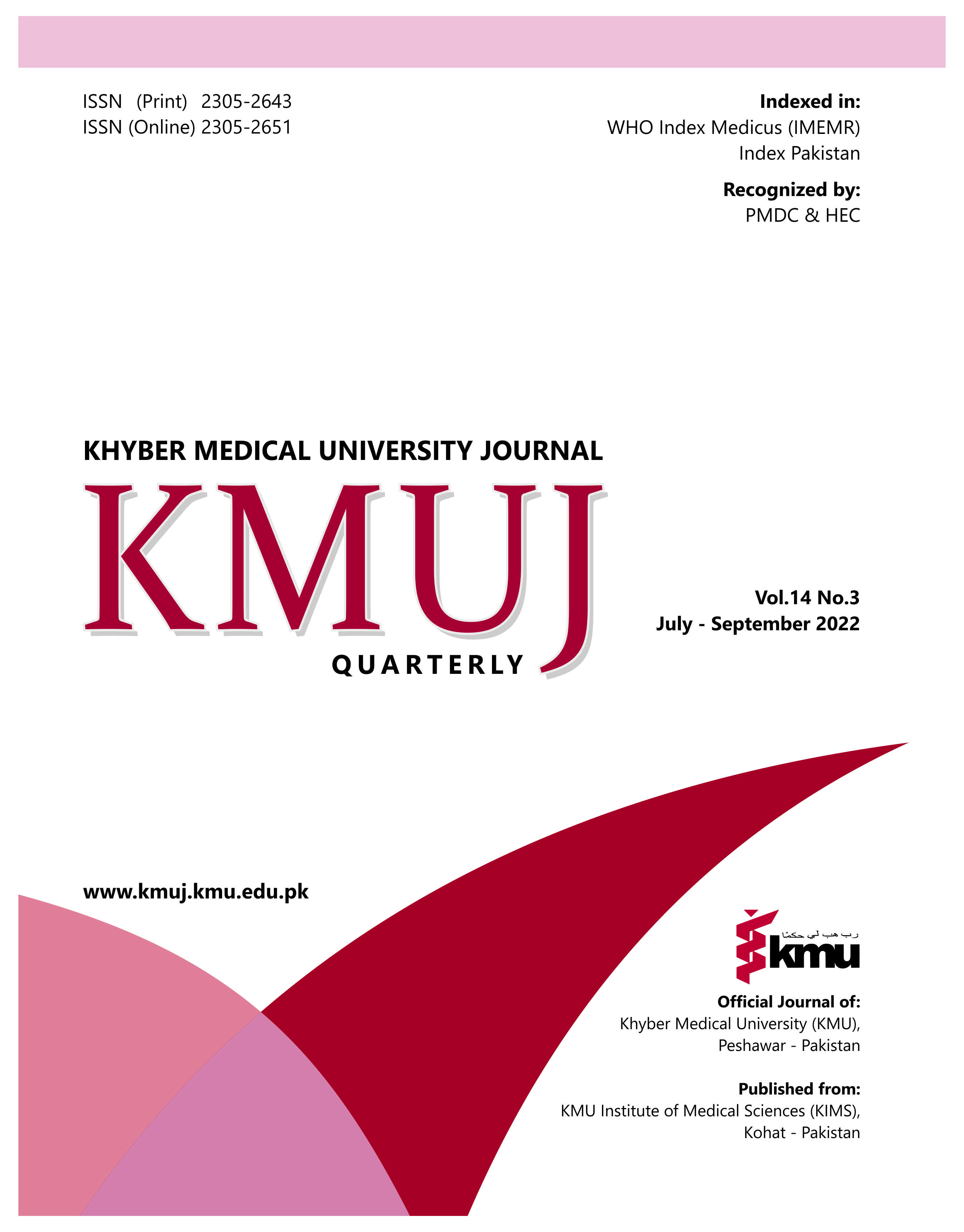ETIOLOGY OF MIDLINE DIASTEMA IN PATIENTS PRESENTING TO NISHTAR INSTITUTE OF DENTISTRY, MULTAN
Main Article Content
Abstract
OBJECTIVE: To find the different etiological factors underlying a midline diastema which will help in effective orthodontic correction by enabling the practitioner to adopt the most appropriate mechanics.
METHODS: This descriptive cross-sectional study was conducted at the Department of Orthodontics, Nishtar Institute of Dentistry, Multan, from 01-08-2020 to 01-02-2021. A sample of 165 patients was analyzed according to age, gender, presenting various occlusal traits, and relevant diastema findings to assess the underlying etiology of the maxillary midline diastema. Cases with a midline diastema of >0.5 mm were documented with examination including clinical intra-oral examination and orthopantomograms and upper occlusal radiographs. Examinations were done by the same observer to reduce human error and were cross-checked by a superior to minimize the possibility of error. The data was analyzed using SPSS version 20.0.
RESULTS: Dental anomalies (n=113, 68.6%) was the most frequent cause of maxillary midline diastema. Dental anomalies were observed in both females (n=77/112; 68.8%) and males (n=36/53; 67.9%). Common dental anomalies included tooth/arch size discrepancies (n=58, 51.3%), abnormal occlusal patterns (n=37; 32.7%) and missing teeth (n=18 15.9%). Other contributing factors for maxillary midline diastema observed were abnormal maxillary arch structure (n=30; 18%), physical impediments (n=18; 11%), muscular imbalances (n=3; 1.8%) and pernicious habits (n=1; 0.6%). Common causes of physical impediments were fleshy labial frenum 10/18; 55.6%) and supernumerary tooth (n=8/18; 44.4%).
CONCLUSION: Maxillary midline diastema was common in both genders and was associated with multiple etiologies of which dental anomalies, abnormal maxillary arch structure and physical impediments were highly prevalent.
Article Details
Work published in KMUJ is licensed under a
Creative Commons Attribution 4.0 License
Authors are permitted and encouraged to post their work online (e.g., in institutional repositories or on their website) prior to and during the submission process, as it can lead to productive exchanges, as well as earlier and greater citation of published work.
(e.g., in institutional repositories or on their website) prior to and during the submission process, as it can lead to productive exchanges, as well as earlier and greater citation of published work.
References
Azzaldeen A, Muhamad AH. Diastema closure with direct composite: architectural gingival contouring. J Adv Med Dent Sci Res 2015;3(1):134.
Abu-Hussein M, Watted N, Abdulgani A. An Interdisciplinary Approach for Improved Esthetic Results in the Anterior Maxilla Diastema. IOSR J Dent Med Sci 2015;14(12):96-101. http://dx.doi.org/10.9790/0853-1412896101
Dewel BF. The labial frenum, midline diastema, and palatine papilla: A clinical analysis. Dent Clin North Am 1966;175-84.
Steigman S, Weissberg Y. Spaced dentition: an epidemiologic study. Angle Orthod 1985;55(2):167-76. https://doi.org/10.1043/0003-3219(1985)055%3C0167:sd%3E2.0.co;2
Nainar SH, Gnanasundaram N. Incidence and etiology of midline diastema in a population in south India (Madras). Angle Orthod 1989;59(4):277-82. https://doi.org/10.1043/0003-3219(1989)059%3C0277:iaeomd%3E2.0.co;2
Richardson ER, Malhotra SK, Henry M, Little RG, Coleman HT. Biracial study of the maxillary midline diastema. Angle Orthod 1973;43(4):438-43. https://doi.org/10.1043/0003-3219(1973)043%3C0438:bsotmm%3E2.0.co;2
Brunelle JA, Bhat M, Lipton JA. Prevalence and distribution of selected occlusal characteristics in the US population, 1988–1991. J Dent Res 1996;75(2_suppl):706-13. https://doi.org/10.1177/002203459607502s10
Huang WJ, Creath CJ. The midline diastema: a review of its etiology and treatment. Pediatr Dent 1995;17(3):171-9.
Ferguson MW, Rix C. Pathogenesis of abnormal midline spacing of human central incisors. A histological study of the involvement of the labial frenum. Br Dent J 1983;154(7):212-8. https://doi.org/10.1038/sj.bdj.4805043
Campbell PM, Moore JW, Matthews JL. Orthodontically corrected midline diastemas: A histologic study and surgical procedure. Am J Orthod 1975;67(2):139-58. https://doi.org/10.1016/0002-9416(75)90066-4
Azzaldeen A, Nezar W, Muhamad AH. Direct bonding in diastema closure high drama, immediate resolution: a case report. Int J Dent Health Sci 2014;01(4):430-5.
Umanah A, Omogbai AA, Osagbemiro B. Prevalence of artificially created maxillary midline diastema and its complications in a selected Nigerian population. Afr Health Sci 2015;15(1):226-32. https://doi.org/10.4314/ahs.v15i1.29
Angle EH. Treatment of Malocclusion of the Teeth: Angle's System. Greatly Enl. and Entirely Rewritten, with Six Hundred and Forty-One Illustrations. 1907, SS White Dental Manufacturing Company; Philadelphia.
Andrews LF. The six keys to normal occlusion. Am J Orthod 1972;62(3):296-309. https://doi.org/10.1016/s0002-9416(72)90268-0
Moyers RE. Handbook of orthodontics. Year Book Medical Pub; 1988. ISBN: 978-0815160038
Becker A: The median diastema. Dent Clin North Am 1978;22:685-710.
Edwards JG. Soft-tissue surgery to alleviate orthodontic relapse. Dent Clin North Am 1993;37(2):205-25.
Clark JD, Williams JK. The management of spacing in the maxillary incisor region. British J Orthod 1978;5(1):35-9. https://doi.org/10.1179/bjo.5.1.35
Bishara SE. Management of diastemas in orthodontics. Am J Orthod 1972;61:55-63. https://doi.org/10.1016/0002-9416(72)90176-5
Kaieda AK, Bulgareli JV, Cunha IP, Vedovello SA, Guerra LM, Ambrosano GM et al. Malocclusion and dental appearance in underprivileged Brazilian adolescents. Braz Oral Res 2019;33:e014. https://doi.org/10.1590/1807-3107bor-2019.vol33.0014
Chaves PRB, Karam AM, Machado AW. Does the presence of maxillary midline diastema influence the perception of dentofacial esthetics in video analysis? Angle Orthod 2021;91(1):54-60. https://doi.org/10.2319/032020-200.1
Bolas-Colvee B, Tarazona B, Paredes-Gallardo V, Arias-De Luxan S. Relationship between perception of smile esthetics and orthodontic treatment in Spanish patients. PLoS One 2018;13(8):e0201102. https://doi.org/10.1371/journal.pone.0201102
Rosenstiel SF, Rashid RG. Public preferences for anterior tooth variations: a web‐based study. J Esthet Restor Dent. 2002;14(2):97-106. https://doi.org/10.1111/j.1708-8240.2002.tb00158.x
Gkantidis N, Kolokitha OE, Topouzelis N. Management of maxillary midline diastema with emphasis on etiology. J Clin Pediatr Dent 2008;32(4):265-72. https://doi.org/10.17796/jcpd.32.4.j087t33221771387
Jan CH, Naureen S, Anwar A. Frequency and etiology of midline diastema in orthodontic patients reporting to Armed Forces Institute of Dentistry Rawalpindi. Pakistan Armed Forces Med J 2010;60(1):126-8.
